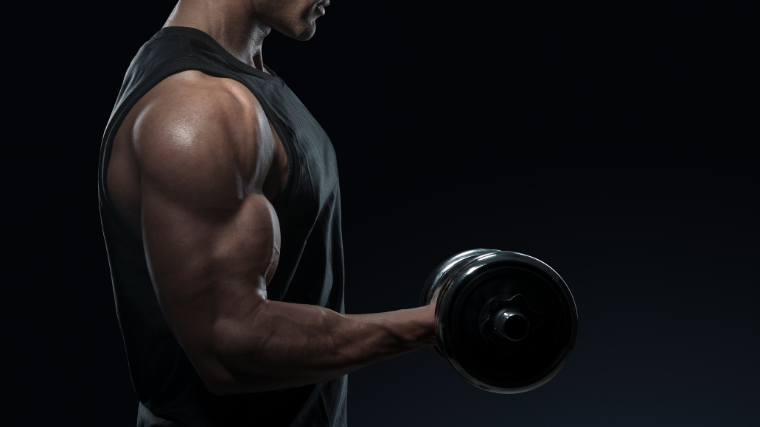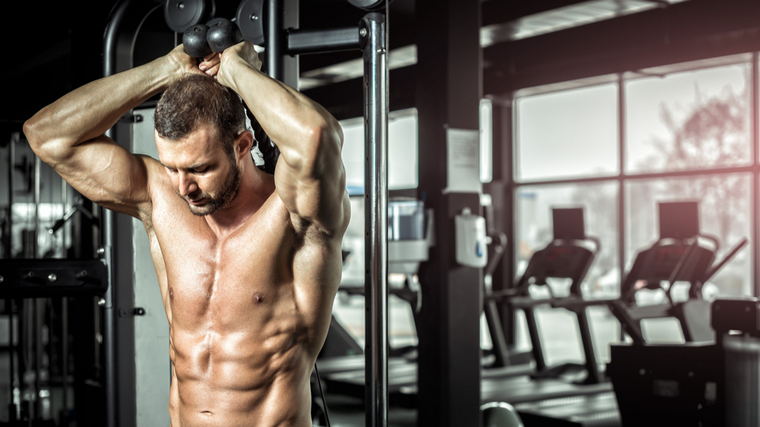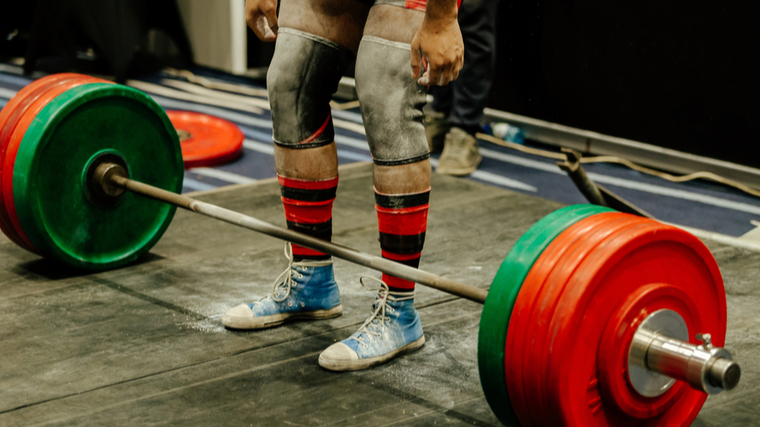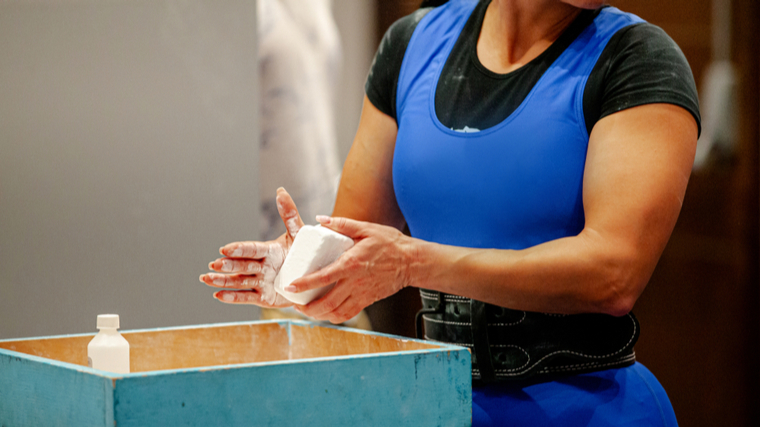Powerlifting is a quantitative sport. In some ways, it’s more about mathematics than muscularity. However, modern powerlifting has started to look beyond the amount of weight on the barbell as the only metric of what makes a successful strength athlete.
You’d be hard-pressed to find an International Powerlifting Federation world-record holder that didn’t look the part. Your legs may do most of the heavy lifting in the sport, but that’s all the more reason to give your arms some love.

If you want to grow your arms and your Total in tandem, you need to know how to properly mix in direct arm work to your existing programming. This guide will help you navigate those waters and, hopefully, blow out your shirt sleeves at the same time.
The Powerlifter’s Guide to Arm Training
- How to Program Arm Training for Powerlifting
- Sample Workouts
- Best Arm Exercises for Powerlifting
- Benefits of Arm Training for Powerlifting
Editor’s Note: The content on BarBend is meant to be informative in nature, but it should not be taken as medical advice. When starting a new training regimen and/or diet, it is always a good idea to consult with a trusted medical professional. We are not a medical resource.
How to Program Arm Training for Powerlifting
Make no mistake — the powerlifts should always take precedence, even if you’re very into the idea of building up your arms.
Integrating direct arm work into your routine should be about complementing what’s already there, not pushing strength-specific work to the side for the sake of squeezing in another set of curls. Let these principles be your guide.
Take It Seriously
Unless you’re in your first year or two of resistance training where the gains flow like a burst dam, you probably won’t beef up your arms just by performing a few sets of curls every week.
You don’t necessarily have to train to complete muscular failure on each set, but research backs the idea that trained populations need to apply more intensity and work near (or at) failure to elicit substantial hypertrophy. (1)
Keep It Brief
You only have so many hours in the weight room each week, and so much energy to work with each session. The lion’s share of each should still go to your sport-specific training, but that doesn’t mean you should sandbag your arm exercises either.
If you want to prioritize arm growth as much as possible, you can perform some direct work prior to your powerlifting training. Think working your triceps before you hit up your back squats for the day.
Note that direct arm training shouldn’t precede the bench press, as doing so may sap your lockout strength. Otherwise, you can generally tack something like 15 to 30 minutes of time onto the end of your session to train your biceps and triceps.
Pick Movements You Enjoy
It shouldn’t merit a mention, but powerlifting is sometimes a very grindy sport. So, make sure that you take the time to include arm exercises that you actually enjoy performing.
This is particularly important since you have the luxury of not being tested in said movements on the competition platform. As such, go for what’s fun and fulfilling. If you dread or have disdain for your arm workouts, you’re not as likely to put in the effort required to benefit from them.
Vary Your Exercises
While you may have sworn an oath to the bench press, back squat, and deadlift, there’s no requirement that you make a similar pledge to the preacher curl (even if it is a fantastic biceps builder).
Regularly rotating your arm exercises can also be a good way to drive progress. Small, single-joint lifts can be difficult to progress in a linear fashion. Most dumbbells go up in five-pound increments, which can be surprisingly difficult progress with.

Jumping from the 25-pounders to the 30s, for instance, is only a five-pound increase but represents a 20 percent leap in intensity. You wouldn’t make a leap like that on your back squat, and it may quickly become impractical to do on your isolation work.
Rotating movements every few weeks — with a similar approach to, say, the conjugate method — lets you push yourself in the short-term and then carve out a new lane to advance through.
Get Away from the Barbell
Powerlifting is inextricably linked to the barbell, but your accessory work doesn’t have to be. Adding some arm-specific exercise into your program is the perfect excuse to dabble in other types of equipment that you otherwise wouldn’t get much value from.
Dumbbells are great for working unilaterally and developing stability. Cables let you apply constant tension across your entire range of motion. Kettlebells alter the physics of lifting by design, providing a unique stimulus. Even the Smith machine has some niche applicability (think exercises like the JM Press or inverted row).
Your arm workouts are the perfect time to widen the range of tools you use to grow and strengthen your body with.
Sample Powerlifting Workouts With Arm Training
Once you have a working understanding of how to integrate direct arm work into your powerlifting routine, seeing it on paper might help coalesce these principles and make them actionable.
These two sample workouts demonstrate how to add direct arm work to a powerlifting workout — they do not represent the only way of doing so.
If you train under the guidance of a coach, best practice is to seek out their advice and let them incorporate arm training in a way that complements, not clashes with, your existing programming.
Arm Work Before Powerlifting
If you really want to put your arm training at the forefront, you can simply stick it at the start of your workout. The most important consideration here is ensuring that the exercises don’t interfere with your sport-specific practice that day.
As such, you should avoid performing triceps training directly prior to a bench-heavy workout. Beyond that, you could try something like this:
- EZ-Bar Skull Crusher
- Single-Arm Cable Triceps Extension
- Back Squat
- Romanian Deadlift
- Back Extension
Blasting your triceps in this fashion shouldn’t add much interference to the lower body workout that follows.
Two exercises prior to hitting up your squat programming shouldn’t take more than 15 minutes at most, and you could even weave those sets in while you’re going through your squat warm-up.
Arm Work After Powerlifting
More often than not, you’re likely to see powerlifters stick any arm-specific accessory work onto the tail end of their session.
Doing so will allow you to funnel a majority of your energy (and mental acumen) directly into your sport-specific training. However, it may make you more likely to go a bit too easy on your arm exercises or cut them out altogether if you’re tired.
Regardless, a workout might look something like:
- Bench Press
- Block Deadlift
- Good Morning
- JM Press superset Preacher Curl
- Reverse Curl
Note that these prescriptions aren’t specific workouts, but are meant to illustrate how you can build and order your exercises such that they don’t interfere with each other.
Placing arm work at the end of your session lets you plug in a bit of extra volume, since there’s nothing left to save your energy for. However, if arm growth is a priority, it does mean you’ll have to conserve some willpower as you work through your powerlifting workouts.
Best Arm Exercises for Powerlifting
The “best “ exercise is the one that is sustainable, progressible, and enjoyable. As long as your movements of choice meet at least two of those criteria, they’re worth including. Hit all three, and you’ve got yourself a golden ticket to gains.
That said, some arm exercises complement powerlifting particularly well, and are popular in strength sports for a reason. You might consider giving these a try when building out your arm routine.
EZ-Bar Skull Crusher
The bench is a surprisingly-effective triceps builder, since your lockout can often make or break a personal record attempt. However, the bench alone won’t fully stimulate the entirety of your tris.
The skull crusher allows you to apply tension to the long head of the triceps, which only really comes into play to a significant degree when your shoulder is flexed above your head.
Working with a cambered barbell should also make the movement a bit easier on your joints, especially if your elbows and wrists are fried from high-volume bench work.
Dumbbell Hammer Curl
Your biceps may not directly contribute to a bigger Total, but that doesn’t mean you should neglect them as a powerlifter. They help stabilize your elbow on the bench, and are put under a high amount of isometric tension when you pull on a heavy deadlift.
As such, an exercise like the hammer curl can be extremely high-value. It effectively trains your biceps, brachialis, forearms, and grip, while also allowing you to work your arms independently.
Single-Arm Cable Triceps Extension
Powerlifting is an entirely-bilateral sport; both of your arms or legs work together at all times. Bilateral training is perfectly fine, but it might mask imbalances in strength or mobility.
The single-arm triceps extension is a great way to make sure your elbow extension strength is equalized side-to-side. As a bonus, it should provide one heck of a pump to your tris if you line the movement up properly.
Standing Cable Curl
Arm training is the perfect time to get away from the barbell and work with different types of equipment. You can use the standing cable curl to take your biceps to the brink and spice up your workouts as well.
The cable attachment provides consistent and reliable tension to your biceps, ensuring you get a lot of bang for your buck. Further, you can use all manner of attachments until you find a grip and hand position that is comfortable and effective.
Cable Wrist Curl
Your forearms can take a serious beating if you train for powerlifting, but mostly work isometrically. It might be wise to balance out that heavy-duty tension with some smaller, targeted forearm work.
The cable wrist curl is a comfortable and convenient way of training wrist flexion under a load that you can easily dial up or down to suit your tolerance.
Benefits of Arm Training for Powerlifting
It may not be strictly critical to success in the gym or on the platform, but that doesn’t mean you have to approach powerlifting from a minimalist perspective.
Some tactically-implemented arm training can add value to your workouts and improve your experience in the gym in more ways than you might think.
More Muscle Mass
Put simply, bigger arms are better arms. Even when accounting for technique or experience, a bigger muscle with more cross-sectional area will be stronger than a smaller one. (2)
As such, growing your arms will make them stronger, which should have some decent carryover to your competition movements — the bench press in particular.
Injury Prevention
Injuries suck and are, unfortunately, an all-too-common occurrence that plague athletes of all levels. Bear in mind, though, that catastrophic injury incidence in strength sports is actually quite low and shouldn’t dissuade you from picking up powerlifting. (3)

Still, your training should go the extra mile toward bulletproofing your body as much as possible. Some literature has shown that arm training, with an emphasis on controlled eccentrics and isometric stability, to be an effective remedy for certain chronic conditions like tendinitis. (4)
Targets Weak Points
You don’t always need to take a hammer to your performance to make changes, sometimes a scalpel will do. If your bench lockout is lacking, for example, more benching might not fix the issue and may even worsen it by reinforcing bad habits. (5)
This is where direct arm work can shine. If you notice a joint or portion of your range of motion to be weak or unstable, you can apply an exercise specifically to treat the issue.
In this case, the JM press or weighted dip, both of which heavily recruit your triceps, might help your bench lockout.
Novelty and Fun
In your pursuit of strength it can be all too easy to forget that going to the gym is supposed to be enjoyable. Dedicated, high-level strength training takes grit and guts, and can be unbelievably monotonous, especially if you’re in the dregs of a high-volume block.
Your arm training can be as much of a performance prescription as it is a creative outlet. Use it to play with movements you’ve always wanted to try, or to work out for the biggest and most skin-tearing pump possible, instead of constantly thinking about technical details or how fast your barbell is moving.

Changing your criteria for success will add longevity to your training, which will ultimately make you a stronger and more robust athlete long-term.
Build Your Arms to Build Your Total
If you want to make the most of your powerlifting training, you have to look past the big three (not too far past, of course). Big arms probably won’t double your Total overnight, but that doesn’t mean curls are off-limits altogether.
As long as it doesn’t interfere with your prime directive — getting as strong as humanly possible, and then a little stronger than that — you should definitely consider adding arm work to your powerlifting programming. After all, your bench isn’t going to press itself.
References
- Nóbrega, S. R., & Libardi, C. A. (2016). Is Resistance Training to Muscular Failure Necessary?. Frontiers in physiology, 7, 10.
- Jones, E. J., Bishop, P. A., Woods, A. K., & Green, J. M. (2008). Cross-sectional area and muscular strength: a brief review. Sports medicine (Auckland, N.Z.), 38(12), 987–994.
- Calhoon, G., & Fry, A. C. (1999). Injury rates and profiles of elite competitive weightlifters. Journal of athletic training, 34(3), 232–238.
- Yoon SY, Kim YW, Shin IS, Kang S, Moon HI, Lee SC. The Beneficial Effects of Eccentric Exercise in the Management of Lateral Elbow Tendinopathy: A Systematic Review and Meta-Analysis. Journal of Clinical Medicine. 2021; 10(17):3968.
- Androulakis-Korakakis, P., Fisher, J. P., & Steele, J. (2020). The Minimum Effective Training Dose Required to Increase 1RM Strength in Resistance-Trained Men: A Systematic Review and Meta-Analysis. Sports medicine (Auckland, N.Z.), 50(4), 751–765.
Featured Image: Improvisor / Shutterstock